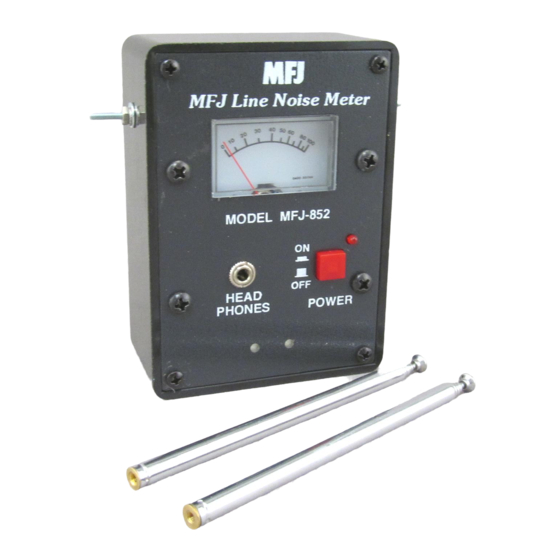
Table of Contents
Advertisement
Quick Links
MFJ-852 Instruction Manual
AC Line Noise Meter
INTRODUCTION
Congratulations on purchasing the MFJ-852 AC Line Noise Meter.
Like
professional RFI trackers used by utility companies, your MFJ-852 leads you to
trouble spots fast. Here are some important features:
VHF Design: The MFJ-852 operates at 135 MHz where antenna length is short,
on-air interference is minimal, and RFI is localized easily for accurate tracking.
Wideband IF: 100 kHz IF bandwidth provides optimized noise sampling.
1 uV Sensitivity: Picks up all noise signatures, weak or strong.
Semi-Log Metering: Semi-log metering system covers a wide signal range
without the need for add-on step attenuators.
Balanced Antenna:
Built-in collapsible dipole is decoupled from case
electronics and headphone leads to deliver a clearly-defined null. Locates RFI
sources easily.
Audio Jack: Plug in stereo or mono type headphones for audible monitoring, or
connect a portable cassette recorder to make sound recordings for later analysis.
Many powerline faults have identifiable noise signatures that experienced
powerline technicians can identify easily--even over the phone!
Battery Indicator: LED power indicator also monitors battery status--let's you
know when it's time to replace the battery before the meter stops working
properly.
Tracks Many Types of RFI: In addition to transmission line noises, the MFJ-
852 also ferrets out residential and industrial noise sources such as electric fence
arcs, sparking power equipment, poorly suppressed specialty lighting, and much
more. Give your claims added credibility by showing the owners of defective
equipment where the problem is being generated--and letting them hear what it
actually sounds like!
Fully Portable: Compact hand-held size and built-in battery power let you to
explore freely in search of trouble spots.
Always Available: Many power-related noise problems are intermittent and
rarely occur when power company engineers are in the neighborhood with the
RFI truck. With the MFJ-852, you can capture the data you need instantly--
when its happening!
Be a detective and put the fun back into Ham Radio! In addition to solving
problems in your own neighborhood, this is a great way to lend assistance to
friends or fellow club members who are having problems of their own. When
1
Advertisement
Table of Contents

Subscribe to Our Youtube Channel
Summary of Contents for MFJ MFJ-852
- Page 1 RFI trackers used by utility companies, your MFJ-852 leads you to trouble spots fast. Here are some important features: VHF Design: The MFJ-852 operates at 135 MHz where antenna length is short, on-air interference is minimal, and RFI is localized easily for accurate tracking.
-
Page 2: Specifications
MFJ-852 Instruction Manual AC Line Noise Meter power companies get a concise description of the noise and a specific pole number, you get much faster service! SPECIFICATIONS Operating Frequency: 135 MHz (internally tunable) Receiver Sensitivity: .3 uV for audible detection Meter Sensitivity: <2 uV for usable deflection... -
Page 3: Hunting Down Noise On The Power Lines
MFJ-852 Instruction Manual AC Line Noise Meter source. Length may be shortened to reduce sensitivity for extremely strong RFI sources. 2. Headphone Jack: Connect standard stereo or monaural type headphones using a 3.5 mm plug. Also, the headphone jack may be used to feed a portable cassette recorder (line-level input)--or even a portable oscilloscope for complex waveform analysis. - Page 4 RFI seems to peak up and hold relatively constant. When you find a "getting-warm" zone, get out of the car and use the MFJ-852 to look for a source (usually a specific pole). You should see (or hear) a null in the RFI noise when the antenna tip is pointed at the source.
-
Page 5: Noise From Other Sources
MFJ-852 Instruction Manual AC Line Noise Meter RFI technicians are skilled at identifying specific problems by the noise signature they generate, which is why we recommend making a cassette recording of the noise. For a fast power company response, always report the following: 1. - Page 6 HF frequencies. When possible, use your car's AM radio to find the general area, then localize the source with your MFJ- 852. For this type of noise, the source is usually located in a building rather than up a pole.
-
Page 7: Theory Of Operation
Your meter has few internal adjustments and is a trouble-free design. However, it has a sensitive electro-mechanical meter that may sustain damage if dropped. Also, the MFJ-852 is not "weatherproof", and should not be exposed to heavy rain, snow, or other harsh environmental conditions. -
Page 8: Technical Assistance
MFJ Technical Service at 662-323- 0549 or the MFJ Factory at 662-323-5869. You will be best helped if you have your unit, manual and all information on your station handy so you can answer any questions the technicians may ask. - Page 9 MFJ-852 Instruction Manual AC Line Noise Meter SCHEMATIC...
















Need help?
Do you have a question about the MFJ-852 and is the answer not in the manual?
Questions and answers